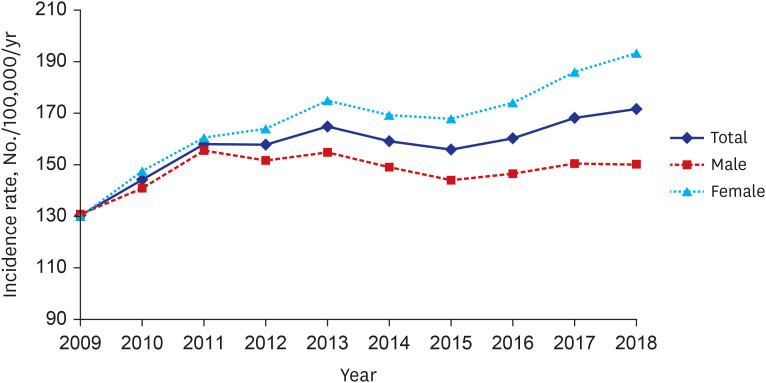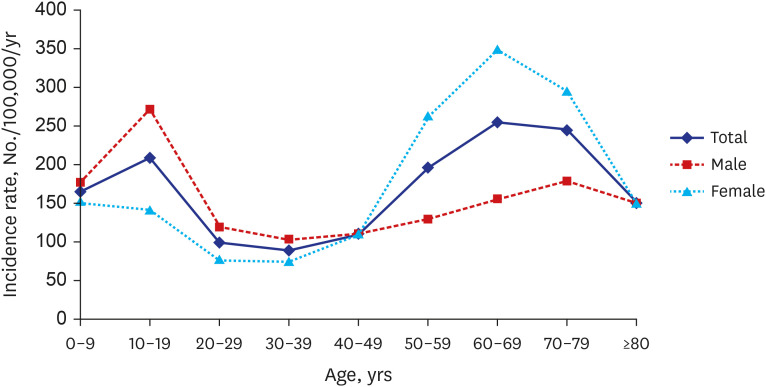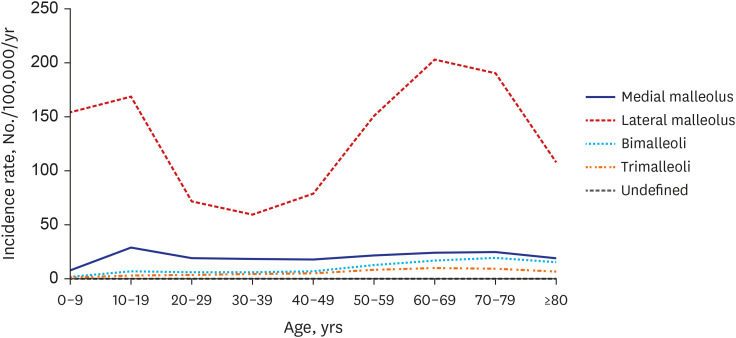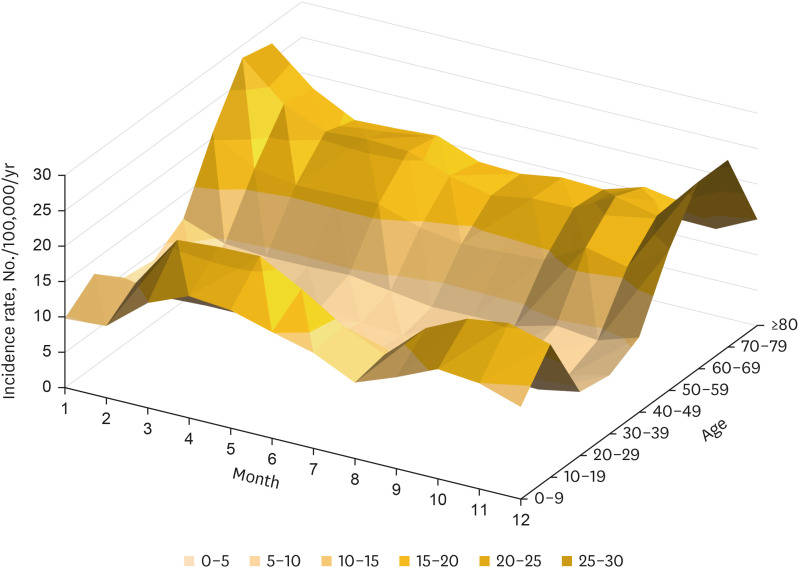J Korean Med Sci.
2022 Oct;37(38):e288. 10.3346/jkms.2022.37.e288.
Epidemiology of Ankle Fractures in Korea: A Nationwide PopulationBased Study
- Affiliations
-
- 1Department of Orthopedic Surgery, Dongtan Sacred Heart Hospital, Hallym University College of Medicine, Hwaseong, Korea
- 2Department of Orthopedic Surgery, Wonju Severance Christian Hospital, Yonsei University Wonju College of Medicine, Wonju, Korea
- KMID: 2533564
- DOI: http://doi.org/10.3346/jkms.2022.37.e288
Abstract
- Background
Although ankle fractures are among the most common fractures, nationwide population-based data on the epidemiology of patients with ankle fractures are scarce. This study aimed to perform an epidemiological analysis of all ankle fractures in Korea from 2010 through 2018.
Methods
We used national registries from the Korean Health Insurance Review and Assessment Service from 2009 to 2018. The annual incidence of the ankle fracture was calculated. The incidence was also calculated according to gender and age. Trends of fracture subtypes were also analyzed. Then, the incidence of ankle fractures by seasonal variation was investigated.
Results
A total of 735,073 ankle fractures were identified in 461,497,758 people for 10 years. The annual incidence of ankle fracture was 171.37/100,000 persons in 2018, with a male to female ratio of 0.78. Interesting differences in the ankle fracture trends were observed between gender. Male shows the highest incidence in adolescence, and the even distribution has lasted for the rest of their lives. In females, the incidence of ankle fracture showed an increasing tendency as their age increased. There was a clear difference in the incidence rate of each season according to age. Ankle fractures occurred more in spring and autumn in children and adolescents and most in winter in the elderly.
Conclusion
Ankle fracture risk was different between sex and exhibited seasonal variations. Our findings can be used for epidemiological awareness and prevention campaigns for ankle fractures.
Figure
Cited by 1 articles
-
Osteoporotic Ankle Fracture
Hyobeom Lee, Cheolhyun Kim, Gab-Lae Kim
J Korean Foot Ankle Soc. 2023;27(2):43-48. doi: 10.14193/jkfas.2023.27.2.43.
Reference
-
1. Court-Brown CM, Heckman JD, McQueen MM, Ricci WM, Tornetta P 3rd, McKee MD. Rockwood and Green’s Fractures in Adults. Philadelphia, PA, USA: Wolters Kluwer Health;2015.2. Bergh C, Wennergren D, Möller M, Brisby H. Fracture incidence in adults in relation to age and gender: a study of 27,169 fractures in the Swedish Fracture Register in a well-defined catchment area. PLoS One. 2020; 15(12):e0244291. PMID: 33347485.
Article3. Court-Brown CM, Caesar B. Epidemiology of adult fractures: a review. Injury. 2006; 37(8):691–697. PMID: 16814787.
Article4. Belmont PJ Jr, Davey S, Rensing N, Bader JO, Waterman BR, Orr JD. Patient-based and surgical risk factors for 30-day postoperative complications and mortality after ankle fracture fixation. J Orthop Trauma. 2015; 29(12):e476–e482. PMID: 25785357.
Article5. Ovaska M. Complications in ankle fracture surgery. Acta Orthop Suppl. 2015; 86(358):1–32.
Article6. Scheer RC, Newman JM, Zhou JJ, Oommen AJ, Naziri Q, Shah NV, et al. Ankle fracture epidemiology in the United States: patient-related trends and mechanisms of injury. J Foot Ankle Surg. 2020; 59(3):479–483. PMID: 32354504.
Article7. Jensen SL, Andresen BK, Mencke S, Nielsen PT. Epidemiology of ankle fractures. A prospective population-based study of 212 cases in Aalborg, Denmark. Acta Orthop Scand. 1998; 69(1):48–50. PMID: 9524518.
Article8. Elsoe R, Ostgaard SE, Larsen P. Population-based epidemiology of 9767 ankle fractures. Foot Ankle Surg. 2018; 24(1):34–39. PMID: 29413771.
Article9. Juto H, Nilsson H, Morberg P. Epidemiology of adult ankle fractures: 1756 cases identified in Norrbotten County during 2009–2013 and classified according to AO/OTA. BMC Musculoskelet Disord. 2018; 19(1):441. PMID: 30545314.
Article10. Thur CK, Edgren G, Jansson KÅ, Wretenberg P. Epidemiology of adult ankle fractures in Sweden between 1987 and 2004: a population-based study of 91,410 Swedish inpatients. Acta Orthop. 2012; 83(3):276–281. PMID: 22401675.11. Koval KJ, Lurie J, Zhou W, Sparks MB, Cantu RV, Sporer SM, et al. Ankle fractures in the elderly: what you get depends on where you live and who you see. J Orthop Trauma. 2005; 19(9):635–639. PMID: 16247309.12. Kannus P, Palvanen M, Niemi S, Parkkari J, Järvinen M. Increasing number and incidence of low-trauma ankle fractures in elderly people: Finnish statistics during 1970-2000 and projections for the future. Bone. 2002; 31(3):430–433. PMID: 12231418.
Article13. Daly PJ, Fitzgerald RH Jr, Melton LJ, Ilstrup DM. Epidemiology of ankle fractures in Rochester, Minnesota. Acta Orthop Scand. 1987; 58(5):539–544. PMID: 3425285.
Article14. Bengnér U, Johnell O, Redlund-Johnell I. Epidemiology of ankle fracture 1950 and 1980. Increasing incidence in elderly women. Acta Orthop Scand. 1986; 57(1):35–37. PMID: 3083643.
Article15. Beerekamp MS, de Muinck Keizer RJ, Schep NW, Ubbink DT, Panneman MJ, Goslings JC. Epidemiology of extremity fractures in the Netherlands. Injury. 2017; 48(7):1355–1362. PMID: 28487101.
Article16. Court-Brown CM, McBirnie J, Wilson G. Adult ankle fractures--an increasing problem? Acta Orthop Scand. 1998; 69(1):43–47. PMID: 9524517.
Article17. Kim L, Kim JA, Kim S. A guide for the utilization of Health Insurance Review and Assessment Service National Patient Samples. Epidemiol Health. 2014; 36:e2014008. PMID: 25078381.
Article18. Jung YS, Han M, Kim DY, Cheon JH, Park S. Cancer risk in Korean patients with Behçet’s disease: a nationwide population-based study. PLoS One. 2017; 12(12):e0190182. PMID: 29287101.
Article19. Shibuya N, Davis ML, Jupiter DC. Epidemiology of foot and ankle fractures in the United States: an analysis of the National Trauma Data Bank (2007 to 2011). J Foot Ankle Surg. 2014; 53(5):606–608. PMID: 24785202.
Article20. Statistics Korea. Updated 2021. Accessed March 10, 2022. http://kostat.go.kr/portal/eng/pressReleases/8/8/index.board .21. Hasselman CT, Vogt MT, Stone KL, Cauley JA, Conti SF. Foot and ankle fractures in elderly white women. Incidence and risk factors. J Bone Joint Surg Am. 2003; 85(5):820–824. PMID: 12728031.22. Open MET Data Portal. Updated 2022. Accessed July 15, 2022. https://data.kma.go.kr/resources/html/en/aowdp.html .





